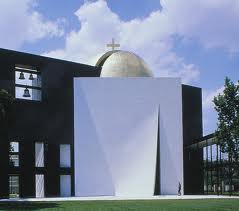Yesterday's architectural entertainment coincided, more or less, with the New York Times article "The Hand of a Master Architect" (Online Sunday, Aug. 8, and in the print edition Monday, Aug. 9).
A search for some background on that architect (Philip Johnson, not Howard Roark) showed that the Art Libraries Society of North America published a notable graphic logo in 2005—

See this journal on April 7, 2005, for a related graphic design.
The ARLIS/NA 2005 page cited above says about Houston, Texas, that
"Just beyond the museum district lies Rice University, the city's most prestigious and oldest college….
Other campuses that contain significant architecture include St. Thomas University where Philip Johnson has made his mark for a period that extends more than forty years."

University of St. Thomas, Chapel of St. Basil
Applying Jungian synchronicity, we note that Johnson designed the Chapel of St. Basil at the University of St. Thomas, that the traditional date of the Feast of St. Basil is June 14, and that this journal on that date contained the following, from the aforementioned Rice University—
… a properly formulated Principle of Sufficient Reason plays
a fundamental role in scientific thought and, furthermore, is
to be regarded as of the greatest suggestiveness from the
philosophic point of view.2
… metaphysical reasoning always relies on the Principle of
Sufficient Reason, and… the true meaning of this Principle
is to be found in the “Theory of Ambiguity” and in the associated
mathematical “Theory of Groups.”
If I were a Leibnizian mystic, believing in his “preestablished
harmony,” and the “best possible world” so satirized by Voltaire
in “Candide,” I would say that the metaphysical importance of
the Principle of Sufficient Reason and the cognate Theory of Groups
arises from the fact that God thinks multi-dimensionally3
whereas men can only think in linear syllogistic series, and the
Theory of Groups is the appropriate instrument of thought to
remedy our deficiency in this respect.
The founder of the Theory of Groups was the mathematician
Evariste Galois….
2 As far as I am aware, only Scholastic Philosophy has fully recognized
and exploited this principle as one of basic importance for philosophic thought.
3 That is, uses multi-dimensional symbols beyond our grasp.
For more about Scholastic Philosophy, see the Center for Thomistic Studies at the University of St. Thomas.
For more about the graphic symbol shown (as above) by ARLIS and by Log24 in April 2005, see in this journal "rature sous rature ."